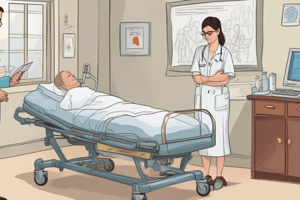Podcast
Questions and Answers
Which of the following are methods of assessment? (Select all that apply)
Which of the following are methods of assessment? (Select all that apply)
- Physical Assessment (correct)
- Observation (correct)
- Patient Interview (correct)
- Dietary Assessment
What is primary data in assessment?
What is primary data in assessment?
Patient Intake
What does subjective data include? (Select all that apply)
What does subjective data include? (Select all that apply)
- Laboratory Results
- Signs
- Health History (correct)
- Symptoms (correct)
Which of the following are considered objective data? (Select all that apply)
Which of the following are considered objective data? (Select all that apply)
What is the purpose of observation in patient assessment?
What is the purpose of observation in patient assessment?
What is a patient interview?
What is a patient interview?
What does demographic data include?
What does demographic data include?
What is the chief complaint?
What is the chief complaint?
What types of allergies and sensitivities should be documented?
What types of allergies and sensitivities should be documented?
Flashcards are hidden until you start studying
Study Notes
Methods of Assessment
- Assessment methods include Observation, Patient Interview, Physical Assessment, Comprehensive Assessment, Focused Assessment, and Emergency Assessment.
Types of Data in Assessment
- Data Collection is a critical aspect of assessment, encompassing both primary data gathered during Patient Intake.
Subjective Data
- Subjective data refers to symptoms and health history provided by the patient which reflects their personal experience of illness.
Objective Data
- Objective data consists of measurable signs, including those obtained from physical examinations, laboratory tests, and diagnostic results.
Importance of Observation
- Observation involves gathering insights into a patient's emotional state, clothing, personal hygiene, and visible physical conditions. Accurate documentation of these observations is crucial during the assessment interview.
Patient Interview
- A formalized Patient Interview involves structured questioning to collect demographic information, health concerns, and medical-surgical histories.
Challenges of Morphology
- Physical assessments may require patient cooperation and specific positioning, which can be challenging for morbidly obese or physically disabled individuals. It's essential to adjust the examination environment as needed.
Demographic Data Collection
- Key demographic data includes Name, Address, Telephone numbers, Age, Birth date, Birthplace, Gender, Marital status, Race, Cultural background, Spiritual preference, Educational level, and Occupation.
Chief Complaint Documentation
- The Chief Complaint is the primary reason a patient seeks care, including details on the onset of symptoms related to their current illness.
Allergies and Sensitivities
- Important to assess include allergies or sensitivities to medications, foods (e.g., peanuts, eggs), environmental agents (e.g., latex), and reactions to reported allergens such as rashes or breathing difficulties.
Studying That Suits You
Use AI to generate personalized quizzes and flashcards to suit your learning preferences.




